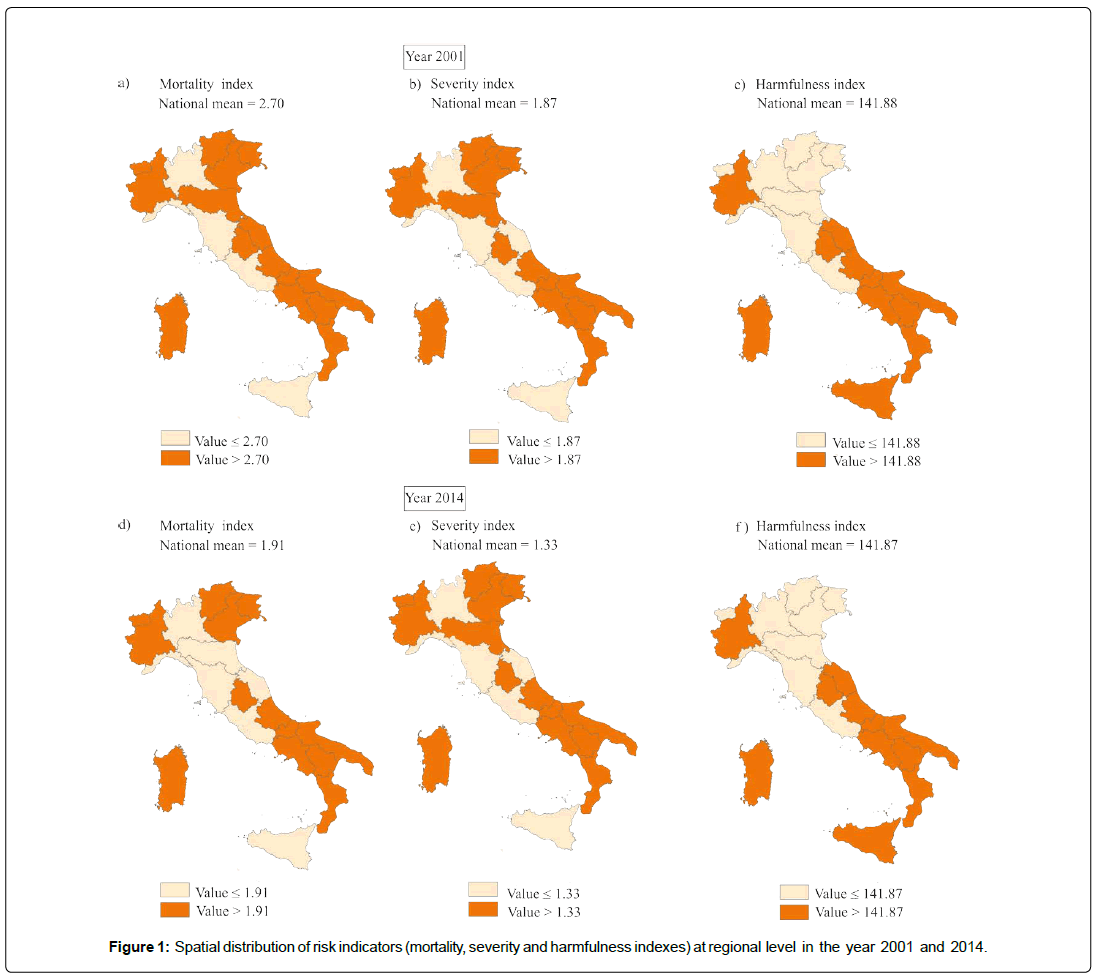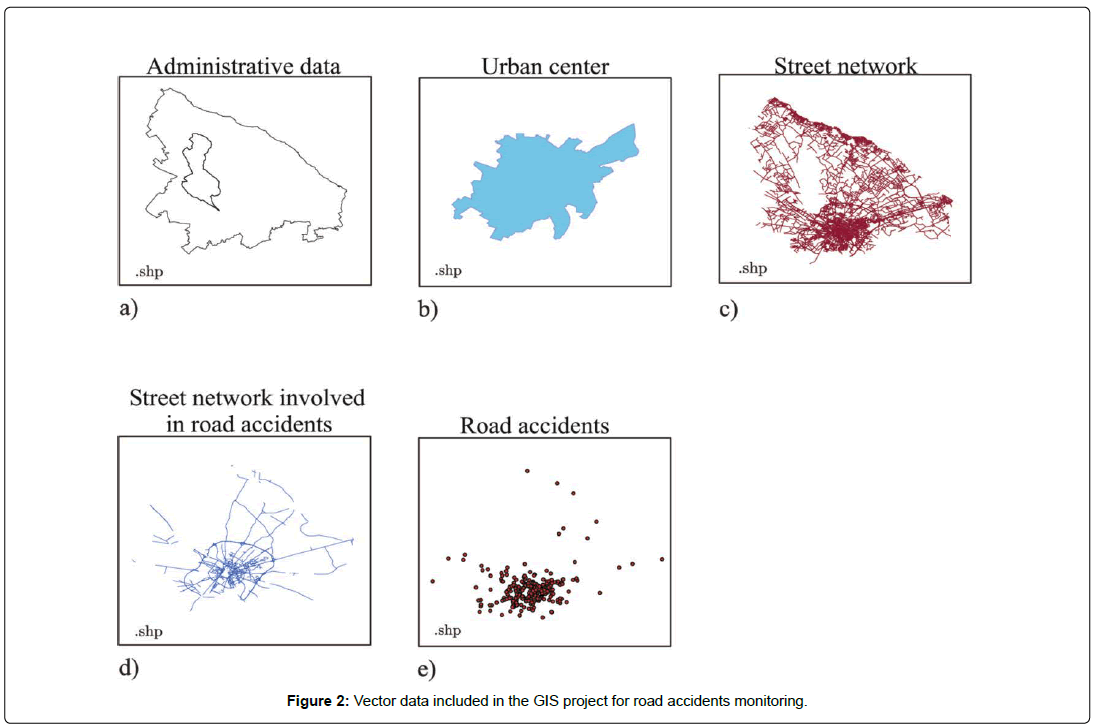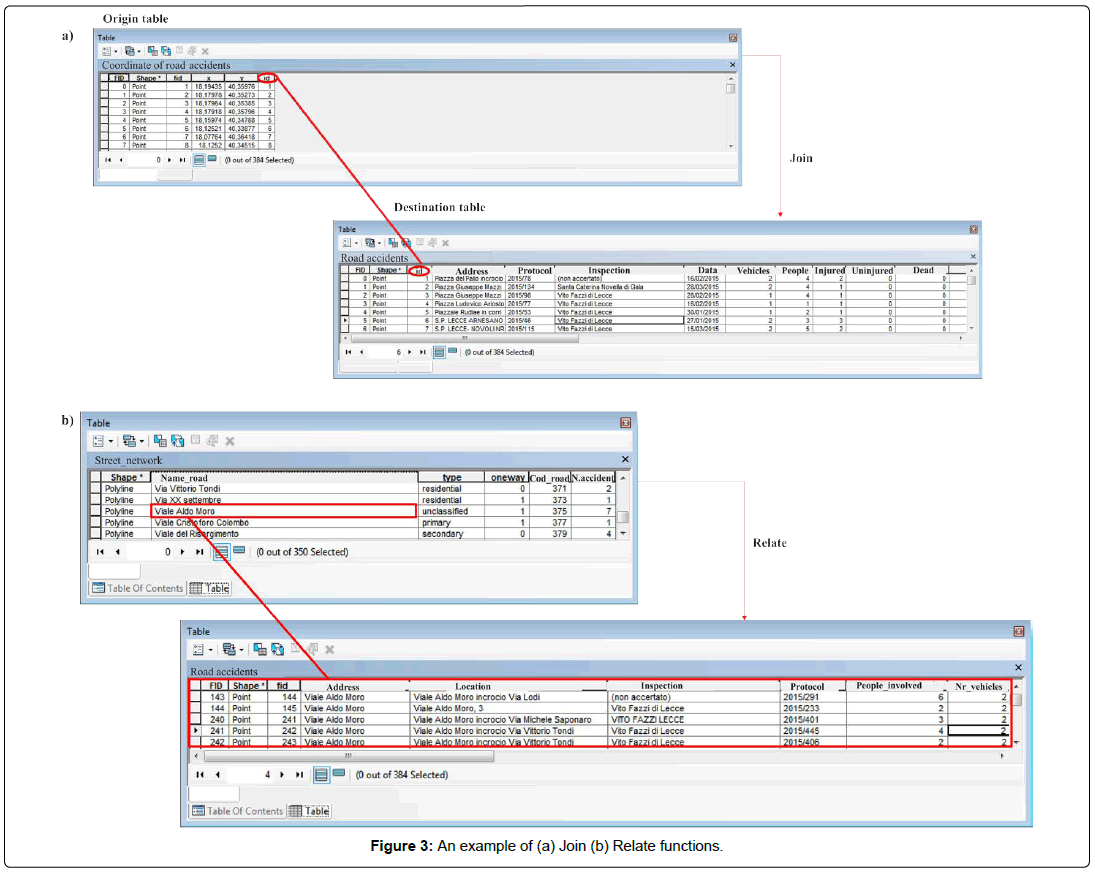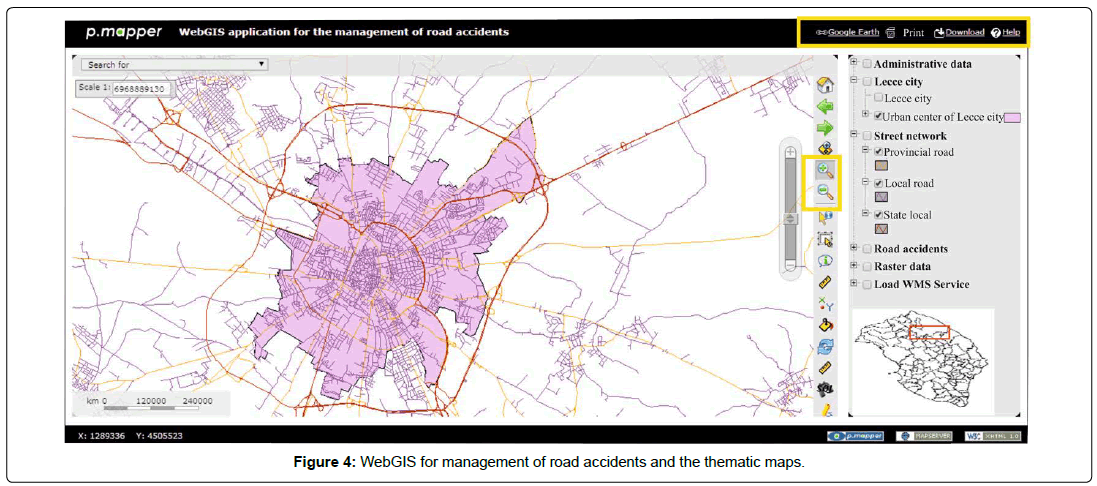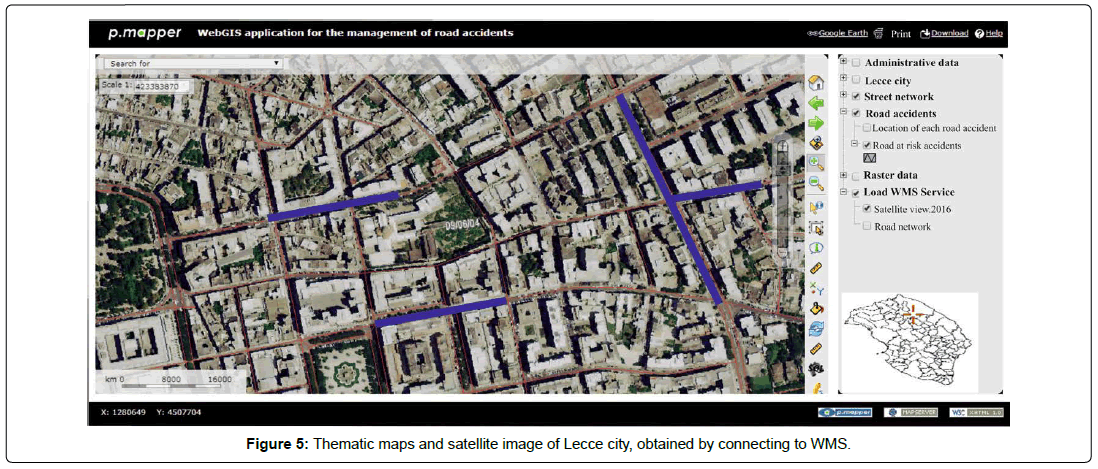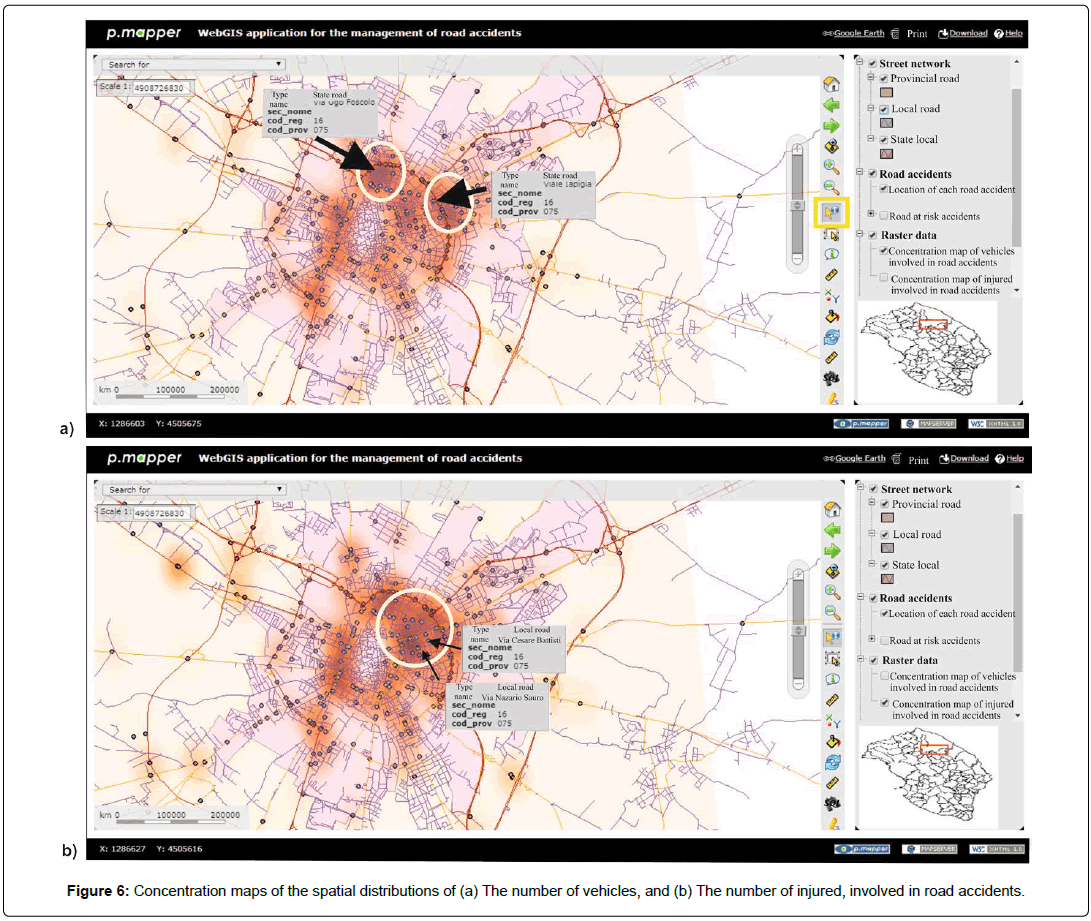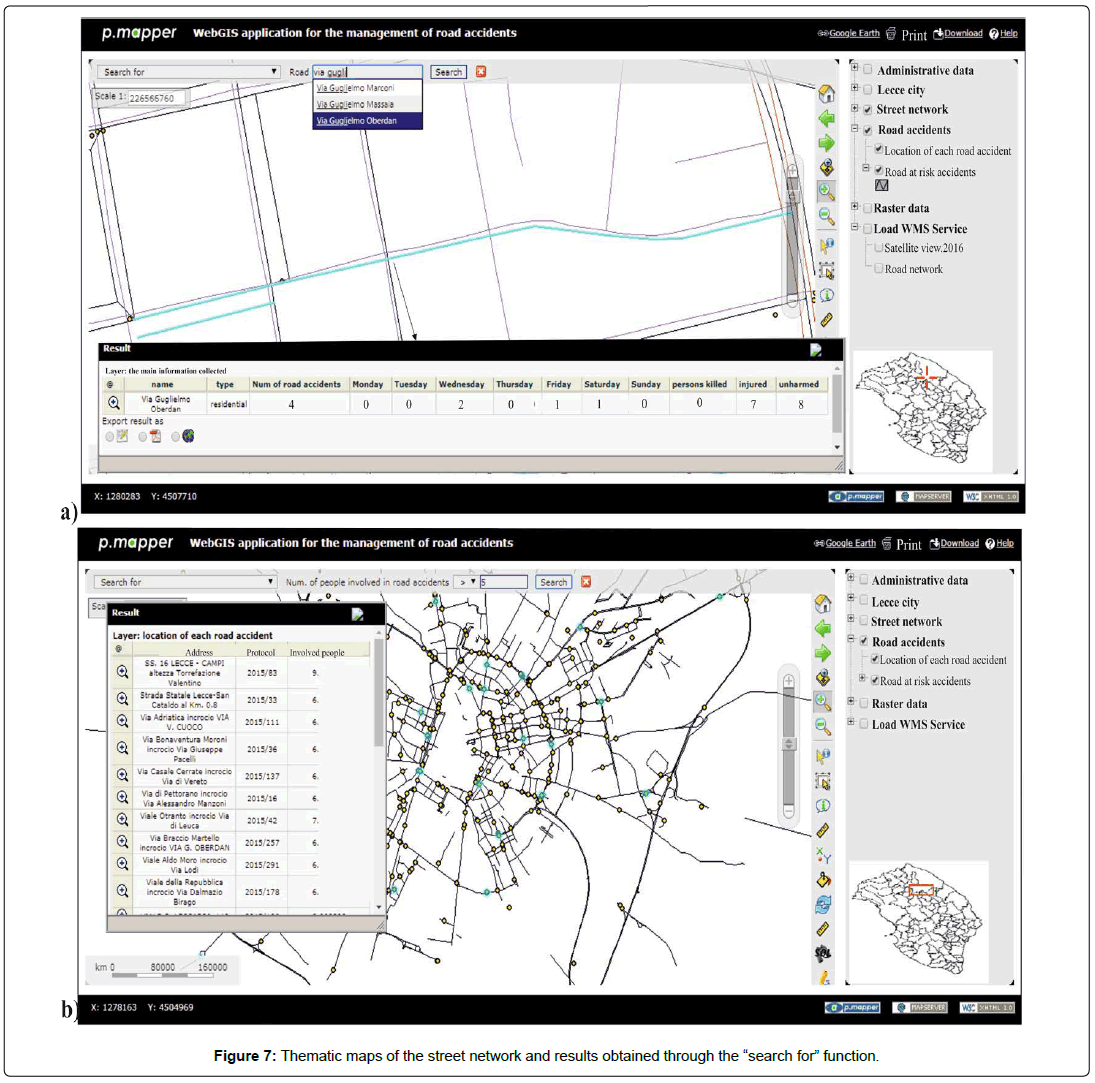Special Issue Article, Geoinfor Geostat An Overview Vol: 0 Issue: 0
A WebGIS for Road Accidents Monitoring in an Urban Area
Distefano V, Maggio S, Palma M*
Universita` del Salento, Dipartimento di Scienze dell’Economia, Complesso Ecotekne, Via per Monteroni, Lecce 73100, Italy
*Corresponding Author: Palma M
Università del Salento, Dipartimento di Scienze dell’Economia, Complesso Ecotekne, Via per Monteroni, Lecce 73100, Italy
Tel: +39 0832 298784
E-mail: monica.palma@unisalento.it
Received: May 28, 2019 Accepted: June 10, 2019 Published: June 17, 2019
Citation: Distefano V, Maggio S, Palma M (2019) A WebGIS for Road Accidents Monitoring in an Urban Area. Geoinfor Geostat: An Overview S2.
Abstract
In the recent years, there is a growing interest in the analysis of spatial distribution of road accidents occurred over a territory, in order to identify the areas which are considered of high risk and improve road safety. In this context, the most advanced information tools, such as Geographical Information System (GIS), allow the collection, management and analysis of large geo-referenced databases concerning qualitative and quantitative information about road accidents. Moreover, a WebGIS, which is a GIS freely usable on the web, makes the data available for all kind of users (policy makers, scientists, analysts) and therefore can be considered a valid support system for planning suitable and effective actions for prevention road accidents.
In this paper, the development of a GIS project and the corresponding WebGIS application for road accidents monitoring over an urban area located in the South of Italy, are proposed. Their main features are discussed in order to highlight the potentiality of these tools in using raw statistical and geographical data to produce meaningful information for spatial analysis, mapping and identifying any factors contributing to road accidents.
Keywords: GIS; Geo-referenced data, Concentration map, Risk indicators
Introduction
In order to reduce road accidents and improve road safety, it is important to understand where the accidents occur most frequently. A punctual identification of the areas with high risk of road accidents can make all efforts for accidents reduction more effective.
Road traffic accidents are increasingly being recognized as one of the issues which provide significant social and economic losses. The global status report on the road safety [1], concerning 180 countries all over the world, pointed out that the worldwide road traffic deaths reach 1.25 million people per year; in particular, road accidents are considered the leading cause of death among young people aged between 15 and 29 years old. According to this report, pedestrians, cyclists and motorcyclists are the most vulnerable and exposed to the risk of accidents.
In addition, road accidents injuries cause considerable economic losses to individuals and nations as a whole. As a result of the road accidents, there are millions of people sustain serious injuries and living with adverse health consequences. This determines in each country a social cost which corresponds approximately at 1% of the GDP (Gross Domestic Product) [1].
Although the recent European statistics on road accidents show an overall reduction of the number of accidents over the long term (2001-2016), further actions and initiatives are needed to increase road safety.
Indeed, the United Nations General Assembly, in 2010, established the Decade of Action for Road Safety (2011-2020), with the goal of halving the number of deaths on roads by 2020, compared to the 2011 records. Currently, the data on accidents show a decreasing trend of the number of road accidents deaths, but this is not jet sufficient to achieve the mentioned goal. For this reason, the first aim of road safety is to reduce the number and severity of traffic accidents by identifying, implementing and evaluating correct measures to improve road traffic.
Recently, the studies concerning the development of new tools for analyzing accidents and road design have increased considerably [2-4]. In this context, the GIS (Geographical Information System) has transformed the whole framework of road accidents processing and analysis. A GIS application allows the integration of several georeferenced data into a unique system, thus simplifying data entry, data analysis and data presentation. The possibility of separating information in layers and combining them with other layers, gives to GIS great potential as research and decision making tool [5]. In this way, a GIS application gives useful information to identify risky areas and help the decision makers in pointing out suitable actions to prevent and reduce road accidents. Moreover, an open source WebGIS can be developed in order to manage and visualize, on the web, information recorded into a GIS. WebGIS applications have modified the traditional way of using GIS, i.e. a database mapping tool [6]. Many recent works have proposed the implementation of WebGIS applications for the management and analysis of environmental spatial data [7] and geo-referenced socio economic data, as well as data concerning archaeological heritage [8,9].
In this paper, a GIS and a WebGIS for managing and monitoring the road accidents over an urban area (Lecce district) located in the South of Italy are proposed. These tools are based on road accidents information system which contains several data about accidents occurred in the study area, such as date, road accident location, number of deaths, vehicles involved. Thus, after a brief discussion about the main risk indicators of the distribution of road accidents in Italy in the years 2001 and 2014, the steps for the implementation of a GIS and a WebGIS for road accidents monitoring in an urban area are thoroughly described. Moreover, on the basis of the data concerning the road accidents in Lecce district for the year 2015, the most important features of the proposed WebGIS are explained.
Note that a huge amount of geo-referenced data is collected in the GIS and consequently in the WebGIS developed for monitoring the road accidents in Lecce district. In this way, the WebGIS represents a very useful tool to identify the “hot spots”, namely subareas which are characterized by high concentration of road accidents. Thus, traffic managers and police officers can easily detect the possible factors around the hot spots that contribute to make those areas more risky and plan effective strategies for protecting them.
Methodology
Risk indicators
In order to analyze the phenomenon of road accidents, three risk indicators have been considered [10,11]:
-Mortality index, calculated through the ratio between the total number of deaths and the number of road accidents for each year,
-Severity index, calculated through the ratio between the total number of deaths and the sum of the number of injured and deaths for each year,
-Harmfulness index, calculated through the ratio between the total number of injured and the number of road accidents for each year.
Figure 1 presents the spatial distribution of the regional risk indicators registered in Italy during the years 2001 and 2014. For each risk indicator, the regions are classified on the basis of the measured value, i.e. if the value is at least equal to the national average or greater.
In the year 2014, the spatial distribution of each risk indicator is quite similar to that observed in 2001. In particular, the spatial distribution of the values exceeding the national average is almost the same in the two years (2001 and 2014) under study.
Note that the national mean of mortality index is decreased from 2.7 in 2001 to 1.91 in 2014, while the severity index is decreased from 1.87 in 2001 to 1.33 in 2014. On the other hand, the harmfulness index has presented, at national level, similar values in 2001 and 2014. According to the results, it is possible to conclude that the mortality index and the index of severity show high values (greater than the national average) in several Regions, such as Valle d’Aosta, Friuli-Venezia Giulia, Basilicata and Molise (with values ranging from 2.60 to 4); while Liguria presents for both risk indicators a better performance with values below the national average (0.69 and 0.54, respectively). The spatial distribution of the harmfulness index shows high values in the Regions situated in the Southern part of Italy.
Geographic data and geo database design
In recent years, the number of studies for analyzing road accidents has increased considerably. In this context a very useful tool is represented by a well-structured GIS project which integrates quantitative and qualitative geo-referenced information about the road networks of the area of interest. In particular, the GIS project proposed in this paper allows the researcher to analyze the risk indicators previously discussed, and is based on the information managed by police officers, as well as the socio demographic information, concerning the people involved in the accidents, managed by hospital and demographic offices.
All these data have been gathered and saved in geographic databases, usually called geo databases. The pilot area is the district of Lecce, an urban area located in the southern part of Apulian Region (Italy). Two data sets have been defined: the first one includes information regarding the road accidents, as the identification code of each accident, the street network, the geographical coordinates of the place where each road accident occurred; the second one records information about the street network in Lecce city, such as length and name of the streets. Note that, it has been necessary to convert the same data into a format supported by the software ArcGIS and subsequently assembled them in thematic layers.
Then the data sets have been imported in the software ArcMap and the corresponding shapefiles (storage format of vectorial data) containing geographic information (location, shape and attributes of spatial entities) and some details about the accidents (for example, type of accident, number of people involved), have been built. In order to define a correct strategy of road accidents’ prevention the above mentioned alphanumeric information need to be integrated with other spatial information, such as the administrative features at provincial and municipal level, as well as the boundaries of the urban center.
Note that these data have been obtained by different sources such as ISTAT (The Italian National Institute of Statistics), the National Geoportal, the Apulian Territorial Information System and police officers. Figure 2 shows the vector data recorded into the proposed GIS project. It is worth highlighting that the list of attributes for the accidents data is regulated by ISTAT, since all public agencies are bound to record the accidents’ characteristics and communicate these data to ISTAT monthly.
A GIS project is also developed to create relationships between data. Indeed, the analyst can define relationships among the tables of different geo-databases on the basis of specific attributes and by using the functions “join” and “relate” (Figure 3). In particular, in a relational database a join function is defined as a link between two tables, by using a common attribute. For instance, it has been defined a join function between the table called “Coordinate of road accidents”, concerning the spatial coordinates of each road accident, and the table called “Road accidents”. In this way, it has been possible to visualize for each accident the corresponding information, regarding the location, number of protocol, inspection, data, number of people involved (injured, uninjured, dead).
The relate function allows the users to identify the accidents which occurred in a specific road of Lecce city: this is a join function of type “one-to-many” between two tables, based on a common name field. Therefore, a relate function between the table called “Street network”, concerning the roads where the accidents occurred, and the table called “Road accidents” allows the users to display information related to each accident detected on that stretch of the selected road.
WebGIS implementation
Internet technology has enhanced the capability of GIS data and software applications by making them more accessible and reachable for a wide range of users, planners and decision makers. It is evident that the integration between GIS tools and internet has improved the access and the use of geospatial data. In this context, a WebGIS represents an efficient way to provide geospatial information without installing a GIS. In particular, a WebGIS provides geographic information on the web through the Hyper Text Transfer Protocol (HTTP) and the Hyper Text Markup Language (HTML). In other words, a WebGIS is an interface to access at several and heterogeneous resources and data service [12].
Hence, a WebGIS is characterized by the following features: online accessibility of geographic, real-time updated data and selection of geographic information by themes. Indeed, the users can simultaneously access to the latest data recorded on servers situated in different locations; evidently these features greatly expand GIS data management capabilities.
The main elements of a WebGIS are: a) a web server, b) a scripting language, c) a database, d) a mapping server and e) an interface for the mapping server.
The data are stored in a Data Base Management System (DBMS), then the platform “MapServer”, which is an open source mapping engine, processes all geographic objects and the results are sent to the web server for publication in the WebGIS portal. A serverside scripting language, named PHP, integrates with MapServer to increase mapping functionality. AJAX (Asynchronous JavaScript and XML) takes care of layout and navigation of resulting data. On the basis of this architecture, the responsibility is on the server side, while the user (or client) needs only a browser in order to use the WebGIS applications. Therefore, the client sends requests to the GIS server, the server performs the task of a file server, which contains the mapping data included in the WebGIS, and then the client visualizes and consults the cartographic map.
In this paper, the WebGIS for road accidents monitoring has been realized by using Open-source technologies, such as a web server called Apache, a MapServer Project and a client interface Pmapper. Moreover, the following information has been included in the proposed WebGIS: administrative boundaries (the provincial borders, the municipal boundaries and the urban center boundaries); the location of road accidents and the street network of Lecce city.
Results and Discussion
The most relevant results regarding the WebGIS for the management of road accidents in Lecce district are listed hereafter.
The WebGIS homepage provides user the possibility to activate various layers and display, on the right side of the WebGIS application, the urban center of Lecce city and the street network of the research area, as shown in Figure 4.
In addition, other layers of information related to the management of road accidents can be overlaid. In particular, the layer called “street network” allows the users to see all roads in Lecce city, classified by type of road such as local, provincial and state road.
Moreover, interactive navigation of maps is possible by the functionality implemented in the WebGIS, such as the use of zooming/ panning available by selecting the object on the map. This application allows a generic number of users to make a print layout of a thematic map of particular interest, or save a data file or an executable file. By using the WebGIS application one can also display information about the parameters related to the geographical reference system, as well as the unit of measurement of the coordinates. Afterwards, the function called “search for” (top left of the Framework p.mapper 4.3) has been implemented and used to query the geo database. All the data are organized in a relational database model ensuring better performance and more advantages. On the other hand, by using the OGC (Open Geospatial Consortium) geoservices it is possible to design the interface through an interoperable and open source software. The OGC consists of over 280 members (governments, companies, universities) and has the purpose of developing and implementing open and extensible standards for geographical data, and their interchange and distribution. The specifications defined by the OGC are public and freely available. The OGC maintains more than 30 standards including: the Web Map Service (WMS), the Web Feature Service (WFS) and the Web Coverage Service (WCS). The service is based on the Web Service approach in order to achieve the integration of the entire system.
In Figure 5 the “location of each road accident” and the “road accidents” layers have been overlapped, since a WMS has been implemented. In particular, the layer “road accidents” contains the segments of roads highlighted in blue that identify the main sections of road where the accidents occurred. Moreover, the OGC WMS standard protocol allows a dynamic visualization of geo-referenced thematic maps, as well as the integration and interoperability of geographic information.
Further insights are described in the “Raster Data” section. Here, there is a sub-section devoted to the spatial analysis, from which the user can get two concentration maps of the spatial distribution of a) the number of vehicles (Figure 6a), and b) the number of injured (Figure 6b), involved in road accidents. Hence, in order to obtain a clustering of accidents with similar characteristics, the two concentration maps and the layer named “location of each road accident” have been overlapped. In this way, it is possible to make a comparison of the two concentration maps, highlighting that, in Lecce city, a large number of vehicles and injured involved in road accidents are recorded near to the peripheral areas. The user can obtain other detailed information by using the “identify” tool, on the navigation bar (Figure 6). Indeed, it is possible to know that the most risky sections of statal and local roads, in Lecce city, are Via Ugo Foscolo, Via Giacomo Leopardi, Viale Japigia, as statal roads, and Via Cesare Battisti and Via Nazario Sauro, as local roads.
On the other hand, the function “search for” has been implemented in order to query the database associated with the layers “accidents” and “roads at risk accidents” and to display, by using both the tabular form and the thematic map, information concerning each road accident or those roads where accidents occurred. Moreover, by using the “search for” function it is possible to view all the data regarding a particular road of interest. For instance, the user can select one road of interest located over the study area and know all information related to that road, as shown in Figure 7a. Similarly, the user can use the “search for” function to select those roads where the accidents involved a fixed number of people; for example, in Figure 7b the “search for” function has been set up in order to show the roads with more than 5 people involved in the accidents.
Evidently, this information allows the police officers to visualize the roads or specific segment of roads which can be considered very dangerous for the public safety.
Conclusion
In this paper a GIS and a WebGIS for managing and monitoring the road accidents over an urban area were proposed. Moreover, a prototype of WebGIS, based on an open source software, was developed for a small city located in the South of Italy. The paper described the main features of the proposed WebGIS, highlighting the usefulness of this tool for the policy makers. Indeed, the huge amount of qualitative and quantitative information geo-referenced over the study area and directly accessible via web, allows the identification of those roads with high risk of accidents and, consequently, the definition and implementation of possible administrative actions aiming to improve road safety over risky areas.
References
- WHO (2015) Global status report on road safety supporting a decade of action.
- Deepthi Jayan K, Ganeshkumar B (2010) Identification of accident hot spots: A GIS based implementation for Kannur District, Kerala. Int J Geomat Geosci 1: 51-59.
- Anitha SDS, Prince GA (2016) Accident and traffic analysis using GIS. Biomed Res (Special Issue): S103-S106.
- Kipngetich A (2011) A road traffic accident study using GIS mapping and analysis: Case study of Nakurua-Eldoret highway. University of Nairobi.
- Shamsi UM (2005) GIS applications for water, wastewater, and stormwater systems. CRC Press.
- Pessina V, Meroni F (2009) A WebGIS tool for seismic hazard scenarios and risk analysis. Soil Dyn Earthq Eng 29: 1274-1281.
- De Iaco S, Maggio S, Palma M (2017) Radon predictions with geographical information system covariates: From spatial sampling to modeling. Geogr Anal 49: 215-235.
- Pelcer-Vujacic O, Kovacevic SA (2016) GIS Database of Montenegrin Katuns. Digital Heritage, Progress in Cultural Heritage: Documentation, Preservation, and Protection, Nicosia.
- Baker TR (2016) WebGIS in education. In: Solari OM et al. (eds.) Geospatial technologies and geography education in a changing world. Springer Japan, pp: 105-116.
- https://www.istat.it/it/archivio.
- Marchetti P, Morandi A, Lombardo C, Gigli Berzolari F, Bruno V, et al. (2009) Human risk factors and injuries due to road accidents: analysis of current data, Epidemiol Prev 33: 154-160.
- Karnatak HC, Sameer S, Bhatia K, Roy PS (2007) Multicriteria decision analysis in WebGis environment. Geoinformatica 11: 407-429.
 Spanish
Spanish  Chinese
Chinese  Russian
Russian  German
German  French
French  Japanese
Japanese  Portuguese
Portuguese  Hindi
Hindi 